In my first little article on Music Theory, I discussed how Pythagoras had such an influence
on our ideas on which musical pitches sounded best, and helped improve the original 7-pitch collections ("scales")
(Link on my "Home" page.) In this article I discuss the musical terminology that is behind the use of harmonic
chords (three notes played at once) to improve our music. Playing a melody one note at a time is like an average
scenic photo on an overcast day, but playing the same melody with 3-note chords is like a sunset photo
with sweeping orange clouds against a dark cobalt sky.
Pitch collections in Western music used 7 notes until somewhere around the 1850s, when 5 new notes were added
(the black keys on a piano), and the new 12-pitch collection was "tuned up" as well. The two main pitch collections
in modern times are:
The C-major Collection, called "Ionian"
The A-minor Collection, called "Aeolian"
A three-note chord is called a Triad. An example is C, E, and G played together. We skip
D and F. The Triad is separated into two "thirds". Each third can be either "Major", with 4 "semi-tones" or "Minor", with
3 semi-tones. (See below). In this example, the C-E note pair is called a major third, and the E-G note pair is a minor third.
In any given pitch collection, musicians sometimes refer to notes as "degrees". So the third note in a pitch
collection is called the "third degree". This is of interest because the third degree of any pitch collection determines
its "Color Tone". If the third degree constitutes a "major third", the collection is usually perceived as "brighter". And
if the third degree of a collection is part of a "minor third", the collection is perceived as "darker". So the E in
a C-major collection marks it as brighter, and the C in the A-minor collection marks it as darker.
"Color tone?", you ask. Why not? Quantum physicists talk of "Color Quarks", so musicians refer to the
"color tone" of pitch collections.
The instrument used in all these sound clips was the Garritan Concert Grand, from the "GPO5" plug-in
("Garritan Personal Orchestra 5").
Major Triads
Triads based on C Major pitch collection (C is the "Tonic"). Notes are C D E F G A B C
 |
Remember that a "Major" pitch collection is a set of 7 keys ("diatonic"), starting from any note
and proceeding like this: Start at C - called the "tonic" Next is D, which is a "whole tone", or two "semi-tones", above C. From C to C# (the black key) is one semi-tone. From C# to D is another semi-tone. Next is E, which is a whole tone, or two semi-tones, above D Next is F, which is a semi tone, (no black key) above E Next is G, which is a whole tone above F Next is A, which is a whole tone above G Next is B, which is a whole tone above A And we end with the C which is one octave above the original tonic, and which is a semi-tone above the B. |
T T S T T T S |
|
In each of these samples, I play each note separately, then the 3-note chord, and finally I repeat the chord three times, while adding each of the three notes an octave lower. For example: C, E, G, C-E-G, C4/C5-E-G, C-E4/E5-G, C-E-G4/G5.
 |
 |
 |
Tonic Triad (I). Notes are C E G 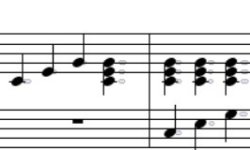
|
Supertonic Triad (II). Notes are D F A 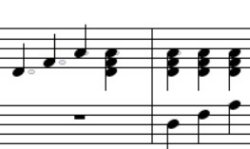
|
Mediant Triad (III). Notes are E G B 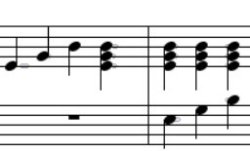
|
 |
 |
 |
Subdominant Triad (IV). Notes are F A C 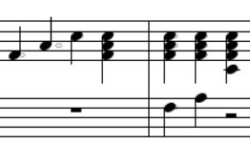
|
Dominant Triad (V). Notes are G B D 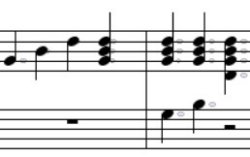
|
Submediant Triad (VI). Notes are A C E 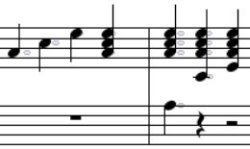
|
 |
 |
 |
Leading Tone Triad (VII). Notes are B D F 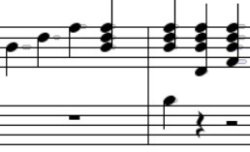
|
And here are all the triads from the C major collection. Notice the "letdown" at the end. That's because the sequence ended with the "Leading Tone" triad. It's called that because it needs resolution! 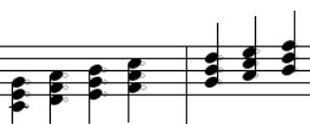
|
So. . . Here it is with the resolution! The resolution happens to be the next available chord. So, if the Leading Tone Triad is B D F, we use C E G, which is the Tonic Triad whose root is the C above the original one. 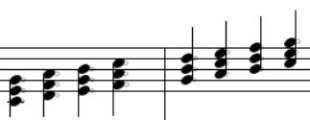
|
Minor Triads
Triads based on C Minor pitch collection (C is the "Tonic"). Notes are C D E♭ F G A♭ B♭ C
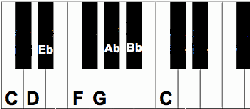 |
Remember that a "Minor" pitch collection is a set of 7 keys ("diatonic"), starting from any note
and proceeding like this: Start at C - called the "tonic" Next is D, which is a "whole tone", or two "semi-tones", above C. From C to D♭ (the black key) is one "semi-tone". From D♭ to D is another semi-tone. Next is E♭ which is a semi-tone above D Next is F, which is a whole tone above E♭ Next is G, which is a whole tone above F Next is A♭, a semi-tone above G Next is B♭, a whole tone above A♭ And we end with the C which is one octave above the original tonic, and which is a semi-tone above the B♭ |
T S T T S T T |
|
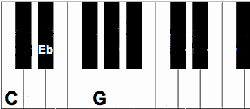 |
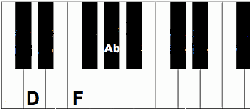 |
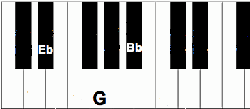 |
Tonic Triad (I). Notes are C E♭ G 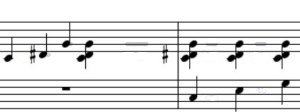
|
Supertonic Triad (II). Notes are D F A♭ 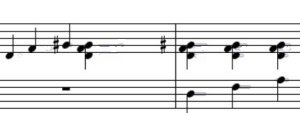
|
Mediant Triad (III). Notes are E♭ G B♭ 
|
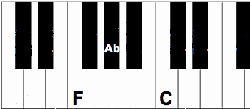 |
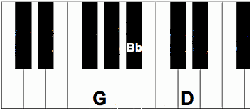 |
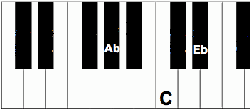 |
Subdominant Triad (IV). Notes are F A♭ C 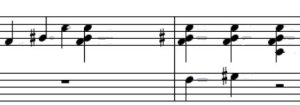
|
Dominant Triad (V). Notes are G B♭ D 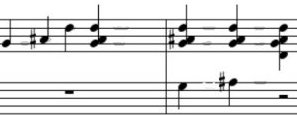
|
Submediant Triad (VI). Notes are A♭ C E♭ 
|
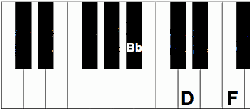 |
 |
|
Subtonic Triad (VII). Notes are B♭ D F 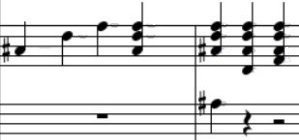
|
And here are all the triads from the C minor collection.
While the seventh triad of the C major collection is called the "leading tone" (diminished) triad, the
seventh triad of the C minor collection is a standard issue major triad 
|
|
You may have noticed that there isn't a great deal of difference between the C major triads and
the C minor triads. That's because only one or two notes change from "natural" to "flat" for each three-note triad. For
example, the Tonic triad of C major is C E G, while the Tonic triad of C minor is C E♭ G.
So here are some recordings of paired minor/major triads, followed by a recording of all the C minor triads
paired with all of the C major triads. It is hoped that these will help you notice the subtle differences.
Triad I, minor (C EB♭ G) vs major (C E G) 
|
Triad II, minor (D F A♭) vs major (D F A) 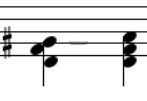
|
Triad III, minor (E♭ G B♭) vs major (E G B) 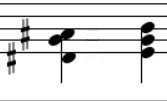
|
Triad IV, minor (F A♭ C) vs major (F A C) 
|
Triad V, minor (G B♭ D) vs major (G B D) 
|
Triad VI, minor (A♭ C E♭) vs major (A C E) 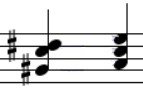
|
Triad VII, minor (B♭ D F) vs major (B D F) 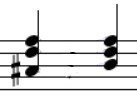
|
|
All 7 C minor Triads, followed by all 7 C major Triads |
Copyright © 2020 J.A.